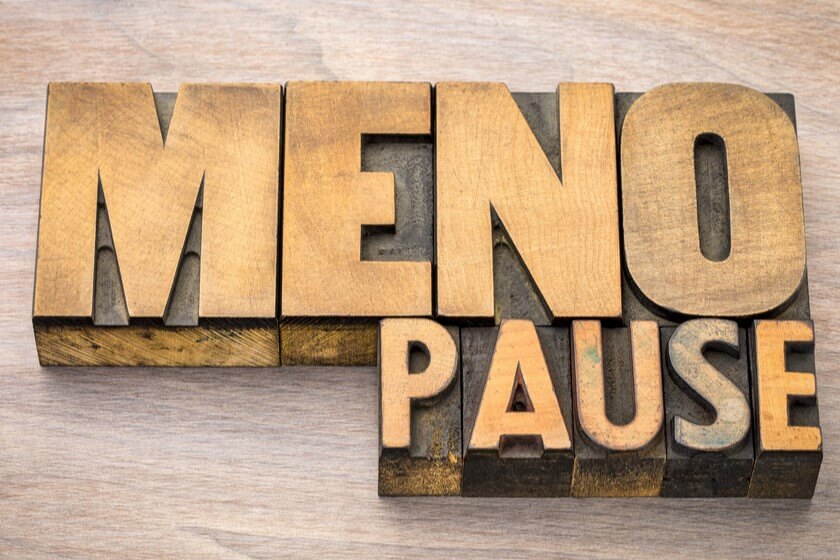Many women dread menopause, and that might well be largely because it’s a bit of giant unknown. One of the best gifts I ever gave to myself was to seek out a doctor that specialized in caring for women at midlife about the time I turned 50. We examined my diet, talked about stress, and of course did the requisite blood work and other tests. I learned along the way that some of the things I was turning to as “healthy” snack foods weren’t really what my body needed, especially at this particular phase of life. I also started working with a nutritionist shortly thereafter, and both of those decisions helped me prepare for managing and mitigating menopause symptoms.
When it comes to menopause (and the perimenopause phase that comes before), my personal philosophy is that I don’t believe in suffering, ever, if it can be avoided. While I had a smattering of hot flashes, some intermittent night sweats, and some insomnia, I knew there had to be a solution, so I made it a point to find the best doctors and discover the best treatments for help with managing and mitigating menopause symptoms—and getting rid of them wherever possible. And that, my middle-aged friends, is my best advice to you. Don’t suffer through menopause, find a wellness practitioner with experience in working with women at midlife, and work together to find a healthcare plan that works for you and your body. I promise you won’t be sorry.
And while you’re researching this critical phase, here’s another article you might want to check out—the truth behind 7 Myths About Menopause
An integral part of a “keeping my sanity while in the midst of menopause” naturally plan involves diet and nutrition. Honestly, I’m not sure the foods you should eat to help with managing and mitigating menopause symptoms are any different than foods you should eat if you’re just trying to be fit and healthy. But I suppose that if you’re at that phase, eating the right kinds of food is really, really important, and if you’re not doing it (yet) maybe now is a good time to start. Let’s take a look at some things you might want to make sure you’re getting into your diet, in one way or another, which will hopefully help you manage and mitigate menopause symptoms:
Foods to Help in Managing and Mitigating Menopause Symptoms
- Dairy (or Calcium). The experts often say you need dairy more than ever during menopause, since this is the time you’re super at risk for osteoporosis. This was actually one thing my doctor told me she wanted me to eliminate from my diet. I don’t drink milk, I eat yogurt a few times a week, but I was turning to cheese as a healthy snack on a daily basis. She asked me to factor out that cheese and simply stick with yogurt. You’ll need to check with your own doctor on the dairy front, but I found that once I factored out cheese, I didn’t really miss it. Whether you get your calcium from dairy products or by way of a supplement, it’s really important to help avoid osteoporosis and the “old lady hunchback” and help keep bones and muscles strong. If you want to make sure you’re getting the right amount of calcium, opt for a calcium supplement. Conveniently, I happen to know a good one!
- Leafy Greens. Leafy greens are pretty much a given when it comes to healthy eating, during menopause or any time. Some of the best (that also happen to be calcium-rich) include mustard greens, kale, and Bok choy. If you’ve not yet tried mustard greens, I love sautéing them in some olive oil with a little minced garlic—delicious!
- Almonds. Almonds have been my go-to snack forever (only 15 at time) (sigh), but they are awesome in so many ways, not only for managing and mitigating menopause symptoms. Not only are they full of healthy fats which is important, they’re also another great source of calcium. So go for it! Get almonds into your daily routine. Grab a handful for a snack, or sprinkle crushed almonds on your favorite cereal, or oatmeal. I make protein balls with almonds to eat post-workout and also sneak almonds into random things, including just about every salad I make. These will fill you up while helping meet your calcium needs as you’re managing menopause. As a bonus, the healthy fats in almonds can fight the effects of low estrogen levels.
- Soy Did you know soy features isoflavones that mimic estrogen, reducing the symptoms of menopause? This means eating things like edamame, tofu, miso, and tempeh can potentially help with managing and mitigating menopause symptoms, while also improving bone health.
- Eggs I was reading an article just this morning about how most people—men and women—eat significantly less protein than they should on a daily basis. Eggs are a fantastic source of protein and they are so easy to integrate into your diet. I love hard boiled eggs, and make a bunch of them every week so that I can have a quick and easay breakfast or lunch solution. I also love fried eggs (and I don’t buy into the whole ‘yolks are bad for you’ business). You can fix omelettes, scramble them, poach them—or even drink them. Ha! I started drinking egg whites with some protein powder after working out and they’re not bad, not bad at all. In addition to helping manage and mitigate menopause symptoms, eggs are packed with vitamin D, vitamin B, and iron. This means they give you energy while also helping you manage your bone health, which is especially important during menopause.
Here’s that article I mentioned earlier, and it’s definitely worth your time to read: Lift Weights, Eat More Protein, Especially If You’re Over 40
- Whole Grains If you’re worried about weight gain during menopause, make sure to get enough fiber in every meal, which helps you stay full longer. Whole grains help with this, especially when you opt for the best whole grain options, like quinoa. Plus, whole grains happen to be one of the menopause superfoods you should eat every day! I am late to the quinoa party but just recently got on the quinoa train and I love it. The cool thing about quinoa is that you can add it to so many different things and it just makes them taste even better. In fact, my favorite new cookie recipe features quinoa, and even my kids love them!
- Veggies It’s not as if we all don’t know how good veggies are for you, so it only makes sense that if you’re fighting the menopause weight gain, it’s important to make sure you’re getting lots of veggies in your diet on a daily basis. They’re generally high in fiber and don’t have many calories. My go-to favorites are sweet potatoes, broccoli, asparagus, cauliflower, beets, tomatoes, and cucumbers. In fact, I’ve gotten to the point lately where I eat veggies for dinner two or three nights a week—and I find that I don’t miss the meat at all. What are your go-to veggies?
- Fruit Fruit is always good to integrate into your diet, but be careful. Talk with your nutritionist as to what fruits to eat and what fruits to avoid, as well as what time of day is best for consuming fruit. My nutritionist has always steered me to berries: strawberries, raspberries, blackberries, blueberries, and I generally only eat fruit during the morning hours. Fruit is full of water, fiber, antioxidants, vitamins, and minerals, so you can’t beat this option for healthy eating during menopause.
- Lean Meat If you’re dealing with mood swings during menopause, one suggestion is to try and get more lean meat in your diet. Not only does your body need the protein, lean meat provides B vitamins and omega-3 fats that can often help stabilize mood and prevent depression. Good lean meat options (and great sources of protein) include some things you might not think of, including the below, which are high in protein, too:

Image credit: Bodybuilding.com
Other lean meats that you might not think of but which are great for managing and mitigating menopause symptoms include veal and bison (which you can find easily and inexpensively at Costco).
- Lentils Lately I am mad about lentils—they are a great addition to your diet when you’re working to manage the symptoms of menopause, especially weight gain. Lentils are also a great source of fiber, and they’re packed with B vitamins. Use lentils as a side, in soups and stews, or even make veggie burgers out of them.
- Seafood It’s no news flash that getting seafood into your diet is important, no matter what your age. But it’s especially helpful for women during menopause. Oily fish, like salmon, cod, and mackerel—provide omega-3s which help manage mood and reduce risk of heart disease. I’m a fan of cod and halibut and buy them both frozen in individual packages at Costco. With the individual packages, you can quickly thaw it in a bowl of water, cook on the stovetop in some olive oil and fresh lemon and you’ve got a quick and easy lunch or dinner that’s low cal, high protein, and really good for you.
You can also get the calcium you need from these Calcium-Rich Foods You Should Eat Every Day
- Flaxseed If you’re looking for a healthy food to sprinkle on pretty much any meal, grab some flaxseed. But here’s the thing—opt for ground flaxseed, rather than whole. The whole flaxseed might look pretty, but nutrition experts recommend ground over whole because the ground is easier to digest. In fact whole flaxseed might pass through your system undigested, which kind of defeats the purpose, no? So grab the ground stuff. It’s high in fiber and omega-3s and you’ll find all kinds of ways to get this into your diet. I recently added it to a cookie recipe, and also put it into waffle mix when I’m making the kids’ breakfast. If it’s good for managing and mitigating menopause symptoms, I’m sure it’s good for 12-year-olds.
- Figs Figs! There is nothing I love more than when figs are in season, and here in the Midwest, we don’t find fresh figs at the grocery store all that often. Figs are not only amazingly tasty, they’re a dairy-free calcium-rich food to snack on. I wrap them with prosciutto and put them in a salad of mixed greens with some balsamic on top—heaven! I also stuff them with goat cheese and pop them into the oven for a few minutes to melt the cheese—also heavenly. Figs not only have lots of calcium, they’re filled with fiber, which helps keep you full. In addition, figs have lots of antioxidants, B vitamins, vitamin A, vitamin C, so there’s really no downside to adding figs to your diet at this time of life.
- Foods Fortified with Vitamin D Calcium and vitamin D work together to keep your bones strong. So it makes sense to eat more of both nutrients to protect your bones from the threat of osteoporosis during menopause. You already know the best sources of calcium, but it’s also important to know some great sources of vitamin D. They include canned tuna, salmon, mushrooms, liver, and anything that has been fortified with this vitamin—which is mostly milk, orange juice, and cereal.
Not sure why vitamin D is so important to managing and mitigating menopause symptoms? Read all about it here: The Deets on Vitamin D – Important Facts You Should Know
If you’re like me, none of those things mentioned are things I enjoy eating (liver, please), that’s all the more reason you need FitFormla’s Cal-EZ Calcium + D. A packet of this flavorless, tasteless powder added to anything you’re eating or drinking can check the box when it comes to getting enough Calcium and vitamin D and helping ward off the old lady hunchback that nobody wants. Try a box for 50% off today using code: FitFormula50 and you’ll be hooked.
Let’s face it, none of this eating advice for managing and mitigating menopause symptoms is rocket science. It’s stuff we pretty much all know, and we may or may not have embraced healthy eating in our relative youth. Once menopause comes along, bodies change, metabolism changes, and sh#t gets real. Which often means revisiting our old habits, keeping the good ones and getting rid of the bad. I don’t know about you, but I’m all in when it comes to doing everything I can to feel great, and look great, no matter what my age. These things are all things I’ve embraced, and habits I’ve adopted as I went through menopause, with great results. I wish the same for you, because not feeling yourself is no fun.
I’ll close by revisiting my most important advice about managing and mitigating menopause symptoms: What works for one woman might not work for others. Find a wellness practitioner who specializes in caring for women at midlife. Make sure you love her (and yes, chances are good it will be a her), and work together to find the plan for managing and mitigating menopause symptoms that work for you. Because it is possible. And you don’t have to suffer through endless sleepless nights, hot flashes, mood swings and the like. These can be managed, I promise!
Other resources on the topic of managing and mitigating menopause symptoms:
How Women Can Get the Calcium They Need to Maintain Bone Health
Managing Menopause: What To Eat and What To Skip
Foods to Help Manage Menopause
The original version of this article was first published on FitFormula Wellness.
- Sesame Beef and Broccoli Recipe - March 16, 2020
- Easy and Best Strawberry Biscuit Recipe - March 15, 2020
- Carb Confusion is Real. Are Carbs Evil? Let’s Do Some Myth-Busting - January 14, 2019









